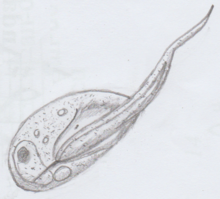| Apusozoa | |
|---|---|

| |
| Apusomonas sp. | |
| Scientific classification (obsolete)
| |
| Domain: | Eukaryota |
| Clade: | Amorphea |
| Clade: | Obazoa |
| Phylum: | Apusozoa Cavalier-Smith 1997 emend. 2013 |
| Groups included | |
| Cladistically included but traditionally excluded taxa | |
The Apusozoa are a paraphyletic phylum[1] of flagellate eukaryotes. They are usually around 5–20 μm in size, and occur in soils and aquatic habitats, where they feed on bacteria. They are grouped together based on the presence of an organic shell or theca under the dorsal surface of the cell.
The name derives from the Ancient Greek words for footless (ἄπους) and animal (ζῷον).[2][3]
This phylum is currently defined as containing the Breviata and the Apusomonadida.[4][5] However, it currently usually is viewed as paraphyletic, with the Breviata as more basal. The opisthokonts appear to have emerged as sister of the apusomonadida. It has been suggested that the Mantamonadida be classified in Apusozoa.[6][7]
The ancyromonadida appear to be Varisulca, Planomonadida, shifting them possibly more basal than the Amoebozoa,[8][9][10] or less basal.[11] While some classification systems have placed Hemimastigida in Apusozoa,[12] 2018 research indicated that hemimastigotes (Hemimastix kukwesjijk/Hemimastix/Spironemidae) are their own supra-kingdom.[13]
Characteristics[edit]
The apusomonads have two flagella inserted at right angles, near the anterior of the cell. They move by gliding, with one flagellum trailing along the side and one directed to the anterior.
The form of the mitochondria varies between the different orders. Among the apusomonads they have tubular cristae, the ancyromonads flat cristae, and the hemimastigids ambiguous or sacculate cristae. This characteristic was originally considered a good indicator of relationships, but is now known to vary even among close relatives.
Evolution[edit]
As currently defined, Apusozoa is a paraphyletic grade that includes two classes: Thecomonadea (the apusomonad flagellates) and Breviatea (the breviate amoebae),[14] each of them monophyletic and sister groups to the Opisthokonta supergroup. Together, these three clades are part of the larger clade Obazoa, which in turn is the sister group to the Amoebozoa supergroup.[15][16]
| Podiata |
|
Apusozoa | ||||||||||||||||||||||||||||||
References[edit]
- ^ Cavalier-Smith T, Chao EE, Stechmann A, Oates B, Nikolaev S (October 2008). "Planomonadida ord. nov. (Apusozoa): ultrastructural affinity with Micronuclearia podoventralis and deep divergences within Planomonas gen. nov". Protist. 159 (4): 535–62. doi:10.1016/j.protis.2008.06.002. PMID 18723395.
- ^ ἄπους. Liddell, Henry George; Scott, Robert; A Greek–English Lexicon at the Perseus Project
- ^ ζῷον. Liddell, Henry George; Scott, Robert; A Greek–English Lexicon at the Perseus Project
- ^ Eme, Laura; Sharpe, Susan C.; Brown, Matthew W.; Roger, Andrew J. (2014-08-01). "On the Age of Eukaryotes: Evaluating Evidence from Fossils and Molecular Clocks". Cold Spring Harbor Perspectives in Biology. 6 (8): a016139. doi:10.1101/cshperspect.a016139. ISSN 1943-0264. PMC 4107988. PMID 25085908.
- ^ Ruggiero, Michael A.; Gordon, Dennis P.; Orrell, Thomas M.; Bailly, Nicolas; Bourgoin, Thierry; Brusca, Richard C.; Cavalier-Smith, Thomas; Guiry, Michael D.; Kirk, Paul M. (2015-06-11). "Correction: A Higher Level Classification of All Living Organisms". PLOS ONE. 10 (6): e0130114. Bibcode:2015PLoSO..1030114R. doi:10.1371/journal.pone.0130114. ISSN 1932-6203. PMC 5159126. PMID 26068874.
- ^ Glücksman E, Snell EA, Berney C, Chao EE, Bass D, Cavalier-Smith T (September 2010). "The Novel Marine Gliding Zooflagellate Genus Mantamonas (Mantamonadida ord. n.: Apusozoa)". Protist. 162 (2): 207–221. doi:10.1016/j.protis.2010.06.004. PMID 20884290.
- ^ Orr, Russell J. S.; Zhao, Sen; Klaveness, Dag; Yabuki, Akinori; Ikeda, Keiji; Makoto, Watanabe M.; Shalchian-Tabrizi, Kamran (2017-10-08). "Enigmatic Diphyllatea eukaryotes: Culturing and targeted PacBio RS amplicon sequencing reveals a higher order taxonomic diversity and global distribution". bioRxiv 10.1101/199125.
- ^ Speijer, Dave; Lukeš, Julius; Eliáš, Marek (2015-07-21). "Sex is a ubiquitous, ancient, and inherent attribute of eukaryotic life". Proceedings of the National Academy of Sciences. 112 (29): 8827–8834. Bibcode:2015PNAS..112.8827S. doi:10.1073/pnas.1501725112. ISSN 0027-8424. PMC 4517231. PMID 26195746.
- ^ Torruella, Guifré; Mendoza, Alex de; Grau-Bové, Xavier; Antó, Meritxell; Chaplin, Mark A.; Campo, Javier del; Eme, Laura; Pérez-Cordón, Gregorio; Whipps, Christopher M. (2015). "Phylogenomics Reveals Convergent Evolution of Lifestyles in Close Relatives of Animals and Fungi". Current Biology. 25 (18): 2404–2410. doi:10.1016/j.cub.2015.07.053. PMID 26365255.
- ^ Cavalier-Smith, Thomas; Chao, Ema E.; Snell, Elizabeth A.; Berney, Cédric; Fiore-Donno, Anna Maria; Lewis, Rhodri (2014). "Multigene eukaryote phylogeny reveals the likely protozoan ancestors of opisthokonts (animals, fungi, choanozoans) and Amoebozoa". Molecular Phylogenetics and Evolution. 81: 71–85. doi:10.1016/j.ympev.2014.08.012. PMID 25152275.
- ^ Paps, Jordi; Medina-Chacón, Luis A.; Marshall, Wyth; Suga, Hiroshi; Ruiz-Trillo, Iñaki (2013). "Molecular Phylogeny of Unikonts: New Insights into the Position of Apusomonads and Ancyromonads and the Internal Relationships of Opisthokonts". Protist. 164 (1): 2–12. doi:10.1016/j.protis.2012.09.002. PMC 4342546. PMID 23083534.
- ^ Cavalier-Smith, Thomas (2003-01-01). "Protist phylogeny and the high-level classification of Protozoa". European Journal of Protistology. 39 (4): 338–348. doi:10.1078/0932-4739-00002. ISSN 0932-4739.
- ^ Chung, Emily (November 16, 2018). "Rare microbes lead scientists to discover new branch on the tree of life". CBC news. Retrieved 16 November 2018.
- ^ Cavalier-Smith T (December 2021). "Ciliary transition zone evolution and the root of the eukaryote tree: implications for opisthokont origin and classification of kingdoms Protozoa, Plantae, and Fungi". Protoplasma. 259: 487–593. doi:10.1007/s00709-021-01665-7. PMC 9010356.
- ^ Derelle R, Torruella G, Klimeš V, Brinkmann H, Kim E, Vlček Č, Lang BF, Eliáš M (2015), "Bacterial proteins pinpoint a single eukaryotic root", Proc Natl Acad Sci U S A, 112 (7): E693–699, Bibcode:2015PNAS..112E.693D, doi:10.1073/pnas.1420657112, PMC 4343179, PMID 25646484
- ^ Adl SM, Bass D, Lane CE, Lukeš J, Schoch CL, Smirnov A, Agatha S, Berney C, Brown MW, Burki F, Cárdenas P, Čepička I, Chistyakova L, del Campo J, Dunthorn M, Edvardsen B, Eglit Y, Guillou L, Hampl V, Heiss AA, Hoppenrath M, James TY, Karnkowska A, Karpov S, Kim E, Kolisko M, Kudryavtsev A, Lahr DJG, Lara E, Le Gall L, Lynn DH, Mann DG, Massana R, Mitchell EAD, Morrow C, Park JS, Pawlowski JW, Powell MJ, Richter DJ, Rueckert S, Shadwick L, Shimano S, Spiegel FW, Torruella G, Youssef N, Zlatogursky V, Zhang Q (2019). "Revisions to the Classification, Nomenclature, and Diversity of Eukaryotes". Journal of Eukaryotic Microbiology. 66 (1): 4–119. doi:10.1111/jeu.12691. PMC 6492006. PMID 30257078.